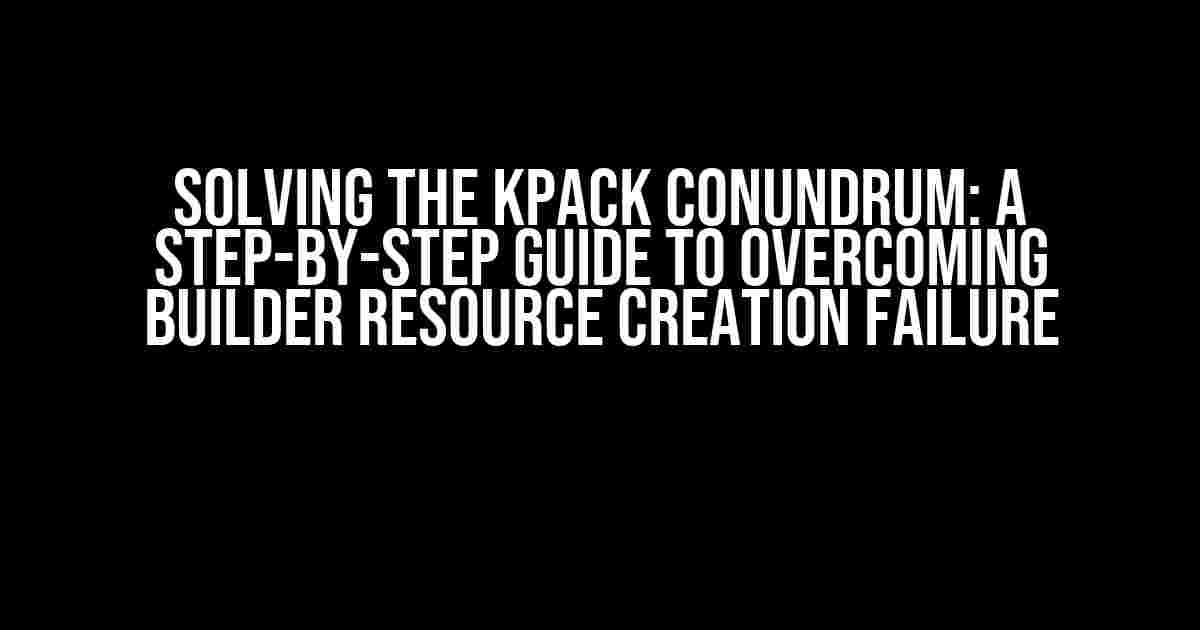Are you tired of encountering the frustrating “Builder resource creation failed” error when working with KPack? You’re not alone! Many developers have fallen victim to this perplexing issue, but fear not, dear reader, for we’re about to embark on a journey to rectify this problem once and for all.
Understanding the Problem
Before we dive into the solution, it’s essential to grasp the root cause of this error. KPack, being a powerful build tool, relies on various resources to function correctly. However, when the builder resource creation fails, it can throw a wrench into your development workflow, leaving you feeling perplexed and frustrated.
So, what exactly triggers this error? There are a few common culprits:
- Corrupted or missing dependencies
- Incorrect configuration or syntax
- Incompatible versions of KPack or its dependencies
- Insufficient system resources or memory
Step-by-Step Troubleshooting
Navigate through the following steps to identify and resolve the “Builder resource creation failed” error:
Step 1: Verify KPack Installation and Configuration
Begin by ensuring you have properly installed KPack and its dependencies. Double-check your configuration files, paying close attention to syntax and formatting. A single misplaced character can cause the entire build process to fail.
// Example configuration file (kpconfig.json)
{
"builders": [
{
"type": "kp.Builder",
"name": "myBuilder",
"dependencies": [
"kp.dependency1",
"kp.dependency2"
]
}
]
}
Step 2: Check for Corrupted or Missing Dependencies
Next, investigate the dependencies listed in your configuration file. Ensure they are correctly installed and up-to-date. You can do this by:
- Running the command `kp dependency list` to verify the installed dependencies
- Checking the KPack documentation for any specific dependency versions required for your build
Step 3: Review System Resources and Memory
Determine if your system has sufficient resources and memory to handle the build process. You can:
- Monitor system resources using tools like Task Manager (Windows) or Activity Monitor (macOS)
- Ensure you have adequate RAM and disk space available
- Consider upgrading your system or reducing the build complexity if necessary
Step 4: Analyze the Build Log
Examine the build log to identify any specific error messages or clues that might indicate the root cause of the failure. Look for lines containing “ERROR” or “FAILED” to pinpoint the issue.
// Example build log output
[INFO] Building myProject
[ERROR] Builder resource creation failed: unable to find dependency 'kp.dependency1'
Step 5: Consult the KPack Documentation and Community Resources
If you’ve reached this step, it’s likely you’ve exhausted the obvious solutions. Now it’s time to:
- Consult the official KPack documentation for any specific troubleshooting guides or known issues
- Browse online forums, such as Stack Overflow or the KPack community forum, to see if others have encountered similar issues
- Search for tutorials or guides specific to your build environment or project type
Common Scenarios and Solutions
Let’s explore some common scenarios and their corresponding solutions:
| Scenario | Solution |
|---|---|
| Corrupted KPack installation | Reinstall KPack and its dependencies |
| Mismatched dependency versions | Update dependencies to the recommended versions |
| Insufficient system resources | Upgrade system resources, reduce build complexity, or optimize the build process |
| Syntax errors in configuration files | Review configuration files for syntax errors and correct them |
Conclusion
By following these steps and troubleshooting techniques, you should be able to overcome the “Builder resource creation failed” error and get your KPack build process back on track. Remember to stay calm, methodically work through the steps, and don’t hesitate to seek help from the KPack community or online resources.
Happy building, and may the KPack be with you!
Last but not least, if you’ve reached this point and still encounter issues, consider creating a minimal, reproducible example (MRE) to share with the KPack community or developers, which can help identify the problem more efficiently.
// Example MRE (kpconfig.json)
{
"builders": [
{
"type": "kp.Builder",
"name": "myBuilder",
"dependencies": [
"kp.dependency1"
]
}
]
}
By providing a concise, reproducible example, you’ll increase the chances of receiving a prompt and accurate solution to your issue.
Frequently Asked Question
Stuck on creating a builder resource with KPack? Don’t worry, we’ve got you covered! Check out these frequently asked questions to get back on track.
What’s causing the “Builder resource creation failed” error?
This error often occurs due to incorrect configuration or missing dependencies in your KPack project. Double-check your project settings, ensure you have the required dependencies installed, and try recreating the builder resource.
How do I troubleshoot the builder resource creation issue?
To troubleshoot, enable verbose logging in KPack, review the logs for error messages, and check the KPack documentation for specific guidance on resolving common issues. You can also try creating a new project or seeking help from the KPack community forum.
Do I need to reinstall KPack to fix the issue?
Not necessarily! Before reinstalling KPack, try cleaning up your project directory, updating your dependencies, and retrying the builder resource creation process. If the issue persists, you can try reinstalling KPack or seeking further assistance from the community.
Can I create a builder resource manually instead of using KPack?
While it’s technically possible to create a builder resource manually, it’s not recommended. KPack is designed to simplify the process and ensure consistency across your project. If you’re experiencing issues, it’s best to troubleshoot and resolve the problem rather than creating a manual workaround.
What resources are available if I’m still stuck?
Don’t worry, you’re not alone! You can refer to the KPack documentation, seek help from the KPack community forum, or explore online tutorials and guides. If you’re still stuck, consider reaching out to a KPack expert or seeking professional assistance.




